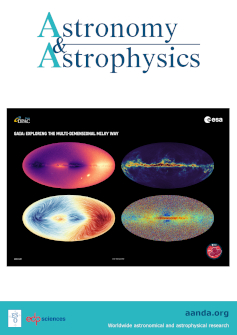银河系核恒星盘中与金属性有关的运动学和轨道
IF 5.4
2区 物理与天体物理
Q1 ASTRONOMY & ASTROPHYSICS
引用次数: 0
摘要
背景。核恒星盘(NSD)是位于银河系中心的一个平坦而致密的恒星结构。之前的研究发现,NSD中存在富金属和贫金属恒星,这表明它们有着不同的起源。最近公布的测光、金属性、适当运动和轨道星表使我们能够以前所未有的详细程度描述NSD恒星群的特征。我们旨在探索不同金属度的NSD恒星的适当运动和轨道,以评估它们是否有不同的起源,并更好地了解NSD的金属度分布。与之前的工作一样,我们采用高斯混合模型区分了富金属和贫金属恒星,并分析了不同金属性恒星的正确运动、轨道和空间分布。我们发现富金属性恒星的速度离散度较低,这表明与贫金属性恒星相比,富金属性恒星追踪的是运动学上较冷的成分。此外,在富金属星中,z-管状轨道占主导地位,而在贫金属星中,混沌/盒状轨道更为常见。我们还发现,富金属和贫金属恒星表现出相似的消光现象,并且存在于整个分析区域。另一个结果是,我们在富金属群中发现了一个金属度梯度,即在NSD中心金属度较高,而在贫金属星中则发现了一个暂定梯度,这与之前没有区分这两个群的研究结果是一致的。我们的研究结果表明,富金属星追踪着NSD,而贫金属星则与银河系条带有关,可能是银河系条带的干涉者和/或源自吸积星团的NSD星。探测到的金属度梯度与目前公认的NSD由内而外形成的观点一致。本文章由计算机程序翻译,如有差异,请以英文原文为准。
Metallicity-dependent kinematics and orbits in the Milky Way’s nuclear stellar disc
Context. The nuclear stellar disc (NSD) is a flat and dense stellar structure at the centre of the Milky Way. Previous work has identified the presence of metal-rich and metal-poor stars in the NSD, suggesting that they have different origins. The recent publication of photometric, metallicity, proper motion, and orbital catalogues allows the NSD stellar population to be characterised with unprecedented detail.Aims. We aim to explore the proper motions and orbits of NSD stars with different metallicities to assess whether they have different origins and to better understand the metallicity distribution in the NSD.Methods. We distinguished between metal-rich and metal-poor stars by applying a Gaussian mixture model, as done in previous work, and analysed the proper motions, orbits, and spatial distribution of stars with different metallicities.Results. We find that metal-rich stars exhibit a lower velocity dispersion, suggesting that they trace a kinematically cooler component compared to metal-poor ones. Furthermore, z-tube orbits are predominant among metal-rich stars, while chaotic/box orbits are more common among metal-poor ones. We also find that metal-rich and metal-poor stars show a similar extinction and are present throughout the analysed regions. As a secondary result, we detected a metallicity gradient in the metal-rich population with higher metallicity towards the centre of the NSD and a tentative gradient for the metal-poor stars, which is consistent with previous studies that did not distinguish between the two populations.Conclusions. Our results suggest that metal-rich stars trace the NSD, whereas metal-poor ones are related to the Galactic bar and probably constitute Galactic bar interlopers and/or are NSD stars that originated from accreted clusters. The detected metallicity gradients aligns with the currently accepted inside-out formation of the NSD.
求助全文
通过发布文献求助,成功后即可免费获取论文全文。
去求助
来源期刊

Astronomy & Astrophysics
地学天文-天文与天体物理
CiteScore
10.20
自引率
27.70%
发文量
2105
审稿时长
1-2 weeks
期刊介绍:
Astronomy & Astrophysics is an international Journal that publishes papers on all aspects of astronomy and astrophysics (theoretical, observational, and instrumental) independently of the techniques used to obtain the results.
 求助内容:
求助内容: 应助结果提醒方式:
应助结果提醒方式:


